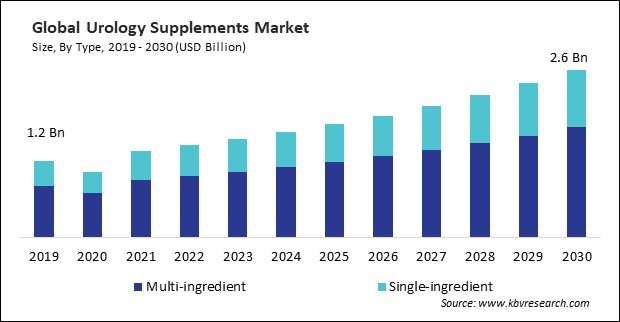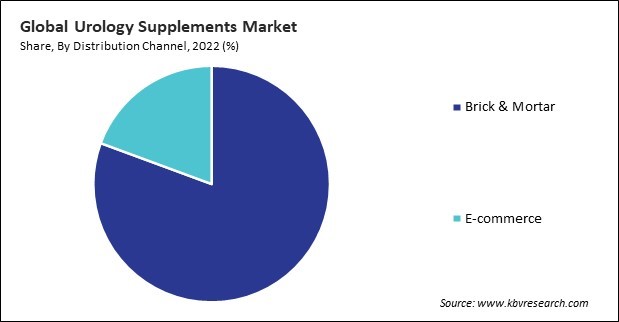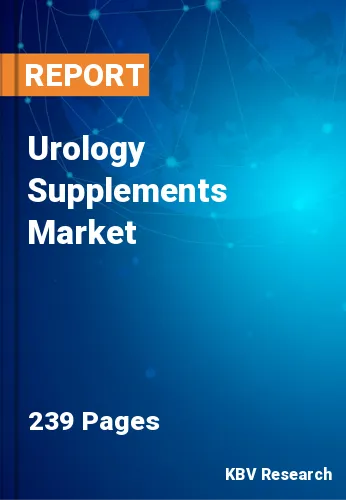“Global Urology Supplements Market to reach a market value of USD 2.6 Billion by 2030 growing at a CAGR of 7.8%”
The Global Urology Supplements Market size is expected to reach $2.6 billion by 2030, rising at a market growth of 7.8% CAGR during the forecast period.
Tablets are convenient and portable, making them ideal dosage forms for consumers who prefer on-the-go supplementation. Thus, the tablets segment acquired $365.29 million revenue in 2022. Their compact size and solid form allow for easy storage, handling, and transport, enabling consumers to take their urology supplements wherever they go, whether at home, work, or while traveling.

Senior citizens place a high value on maintaining their quality of life and independence as they age. BPH and urinary incontinence are urological conditions that can substantially negatively affect an individual's quality of life by interfering with social interactions, daily activities, and overall wellness. Therefore, the market is expanding significantly due to the increasing number of senior citizens.
Additionally, Natural and herbal remedies are often perceived as safer alternatives to synthetic medications and pharmaceutical drugs. Many consumers prefer natural supplements for urological health because they believe they have fewer side effects and lower risks than prescription medications. Thus, because of the rising preference for natural and herbal remedies, the market is anticipated to increase significantly.
The COVID-19 pandemic affected research and development activities in the market, with some companies reallocating resources and focusing on pandemic-related research and therapies. However, the pandemic has also spurred innovation in the development of urology supplements, particularly in immune support, telehealth integration, and digital health technologies. Thus, the COVID-19 pandemic had a moderate effect on the market.
However, Supply chain disruptions, including factory closures, transportation bottlenecks, and labor shortages, can result in manufacturing delays and capacity constraints for urology supplement producers. Manufacturers may struggle to meet demand due to reduced production output, longer lead times, or the allocation of resources to prioritize essential products over dietary supplements. Thus, supply chain vulnerabilities can slow down the growth of the market.
By type, the market is bifurcated into multi-ingredient and single-ingredient. The single-ingredient segment covered a considerable 33% revenue share in the market in 2022. Single-ingredient supplements offer transparency and simplicity in product formulations, making it easier for consumers to understand and evaluate the ingredients they are consuming.
By distribution channel, the market is categorized into brick & mortar and e-commerce. In 2022, the brick & mortar segment registered the maximum 80% revenue share in the market. Consumers can purchase urology supplements directly from physical retail locations in their local communities through brick-and-mortar stores, which offer convenient access to these products.

Based on application, the market is classified into urinary tract infections, kidney health, prostate health, and bladder health. The kidney health segment acquired a substantial 16% revenue share in the market in 2022. Urology supplements serve as a complementary therapy for individuals with existing kidney disorders, such as CKD or kidney stones.
On the basis of formulation, the market is divided into capsules, softgels, tablets, liquid, and others. In 2022, the capsules segment dominated the market with 39% revenue share. Capsules offer enhanced stability and protection for sensitive ingredients, such as probiotics, enzymes, vitamins, and herbal extracts, compared to other dosage forms.
Free Valuable Insights: Global Urology Supplements Market size to reach USD 2.6 Billion by 2030
Region-wise, the market is analysed across North America, Europe, Asia Pacific, and LAMEA. In 2022, the North America region led the market by generating 36% revenue share. North America has a rapidly aging population, with a large segment of baby boomers entering their senior years. In North America, there is a growing recognition of the significance of preventive healthcare.
| Report Attribute | Details |
|---|---|
| Market size value in 2022 | USD 1.4 Billion |
| Market size forecast in 2030 | USD 2.6 Billion |
| Base Year | 2022 |
| Historical Period | 2019 to 2021 |
| Forecast Period | 2023 to 2030 |
| Revenue Growth Rate | CAGR of 7.8% from 2023 to 2030 |
| Number of Pages | 239 |
| Number of Tables | 450 |
| Report coverage | Market Trends, Revenue Estimation and Forecast, Segmentation Analysis, Regional and Country Breakdown, Porter’s 5 Forces Analysis, Company Profiling, Companies Strategic Developments, SWOT Analysis, Winning Imperatives |
| Segments covered | Type, Formulation, Distribution Channel, Application, Region |
| Country scope |
|
| Companies Included | Himalaya Wellness Company (Himalaya Global Holdings Ltd.), Nature's Bounty (Nestlé Health Science S.A.) (Nestle S.A.), Theralogix, LLC, Zahlers, Natrol, LLC, The Himalayan Organics (Vlado Sky Enterprises Pvt. Ltd), Solaray Inc. (Nutraceutical International Corporation), Schiff Nutrition International, Inc. (Reckitt Benckiser Group plc), Biotex Life Solutions Private Limited, DSE Health Care Solutions, Inc. |
By Type
By Distribution Channel
By Application
By Formulation
By Geography
The Market size is projected to reach USD $2.6 billion by 2030.
Rising preference for natural and herbal remedies are driving the Market in coming years, however, Global supply chain vulnerabilities restraints the growth of the Market.
Himalaya Wellness Company (Himalaya Global Holdings Ltd.), Nature's Bounty (Nestlé Health Science S.A.) (Nestle S.A.), Theralogix, LLC, Zahlers, Natrol, LLC, The Himalayan Organics (Vlado Sky Enterprises Pvt. Ltd), Solaray Inc. (Nutraceutical International Corporation), Schiff Nutrition International, Inc. (Reckitt Benckiser Group plc), Biotex Life Solutions Private Limited, DSE Health Care Solutions, Inc.
The Multi-ingredient segment is generating the highest revenue in the Market by Type in 2022; thereby, achieving a market value of $1.7 billion by 2030.
The Urinary Tract infections segment is leading the Market by Application in 2022; thereby, achieving a market value of $967.7 million by 2030.
The North America region dominated the Market by Region in 2022, and would continue to be a dominant market till 2030; thereby, achieving a market value of $889.9 million by 2030.
Our team of dedicated experts can provide you with attractive expansion opportunities for your business.

 Drivers
Drivers
 Restraints
Restraints
 Opportunities
Opportunities
 Challenges
Challenges
